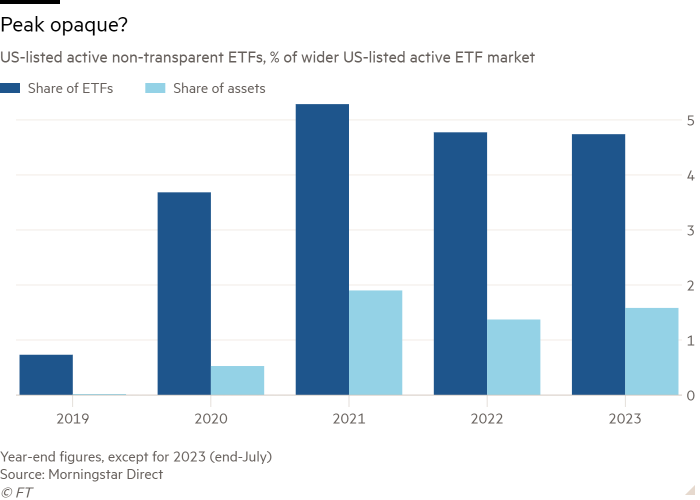Secretive active ETFs lose out to their fully transparent rivals

Simply sign up to the Exchange traded funds myFT Digest -- delivered directly to your inbox.
Secretive exchange traded funds that hide what they are holding from potential investors appear to be falling out of favour.
US regulators approved semi- and non-transparent ETFs in 2019, paving the way for the structure to depart from the tried-and-trusted model where ETFs reveal their full portfolio publicly every day.
The new “portfolio-shielding” models were expected to encourage actively managed funds to enter the ETF market, something many active managers had been reluctant to do because they feared daily holdings disclosures would reveal their “secret sauce”, allowing other investors to front-run their funds and steal their intellectual property.
ETFs adopting semi- and non-transparent structures can instead opt to reveal only a snapshot of their holdings on a monthly or quarterly basis, similar to the limited level of transparency offered by many mutual funds. Alternatively, they may reveal their holdings, but not how much of each security they hold.
However, after initial enthusiasm growth of these novel structures has stalled as investors have largely shunned them and ETF issuers have become more comfortable with full transparency.
“Semi-transparent ETFs are dead,” said Michael O’Riordan, founding partner of consultancy Blackwater Search and Advisory. “None of them really gained any traction in terms of raising assets. Investors voted with their wallets and a lot of advisers bypassed them completely.”
“Most asset managers have focused on fully transparent active approaches as they enter the ETF market or have added in a mix of fully and semi-transparent funds,” said Todd Rosenbluth, head of research at VettaFi.

Active non-transparent ETFs exhibited strong growth in their formative years, data from Morningstar Direct show.
Between year-end 2019 and the end of 2021 the assets of US-listed active non-transparent ETFs jumped from just $20mn (in three ETFS) to $5.6bn (spread across 45).
At that juncture non-transparent ETFs accounted for 5.3 per cent of all US-listed active ETFs and 1.9 per cent of assets, the data shows.
However, rather than being a springboard for further growth, December 2021 represented a pinnacle for the popularity of active non-transparent funds as they began to lose market share to their fully transparent active rivals.
As of the end of July this year, total assets in non-transparent ETFs had edged up to $7.1bn, spread across 55 funds, Morningstar found.
But the vehicles now account for just 4.7 per cent of the 1,160 US-listed active ETFs and 1.6 per cent of their $447bn of assets. Moreover $2.7bn, 38 per cent of that limited pot of money, is held by a single ETF, Nuveen Growth Opportunities (NUGO).
The pace of launches has also slowed, from a peak of 24 in 2021 to nine in 2022 and eight in the first seven months of this year.
Some fund houses have thrown in the towel. Franklin Templeton last year converted its only non-transparent ETF, the ClearBridge Focus Value ESG ETF (CFCV) into a conventional transparent vehicle, expressing confidence that it can “manage the fund efficiently and effectively while publicly disclosing portfolio holdings on a daily basis”.
In June, T Rowe Price launched its first five active transparent equity ETFs, a departure from the semi-transparent model it used for its previous five-strong roster of active equity ETFs in 2020 and 2021.
T Rowe told the FT that it was responding to “our clients’ diverse and evolving preferences”, and that its second tranche of ETFs were “new and distinct strategies”, whereas the initial quintet had been based on its existing mutual fund strategies.
Growth in other markets has been held back by regulators, with the European Union yet to approve any semi- or non-transparent ETF structures, although they are available in Canada and Australia.
“Conceptually, ETFs are meant to be very transparent by their nature, and now we have introduced something that says it is only semi-transparent. That’s something that goes against the grain,” O’Riordan argued.
He pointed out that Cathie Wood’s Ark Invest was the “posterchild” for active ETFs embracing transparency, with its popular six-strong active ETF range using the traditional ETF structure.
He accepted that the threats of IP theft and being front-run were “valid concerns” but believed in practice “it hasn’t been borne out. It’s not a real risk, it’s a theoretical risk. I don’t think it happens that often,” he said.
As a result, the industry had become comfortable with full transparency, O’Riordan argued.
“The semi-transparent vehicle had a short life, but we think the end is nigh,” he added.
Rosenbluth cited the limitations of semi- and non-transparent ETFs for their relative lack of traction. In particular, he noted that, per SEC rules, these structures are only allowed to hold US securities and American depositary receipts, meaning any ETF that wants to hold any foreign-listed stocks must be transparent.
Rosenbluth was unwilling to sound the death knell for the concept, however.
He argued that for investment houses that offer the same strategy in both ETF and mutual fund formats “the semi-transparent approach makes sense” as “all shareholders own the same securities and management can avoid sharing proprietary information”.
Moreover, Rosenbluth believed “small cap is an investment style that makes more sense in a semi-transparent structure” because shares in smaller companies tend to be less liquid than blue-chip stocks.
He cited the JPMorgan Active Small Cap Value ETF (JPSV), the manager’s first semi-transparent ETF, which launched in March, as a prime example.
Analysts at the banking arm of JPMorgan also believe the concept still has a future.
Although they concede that the adoption of semi- and non-transparent ETF structures “has been relatively slow”, they expect further growth as “investors become more familiar with them”.
Comments